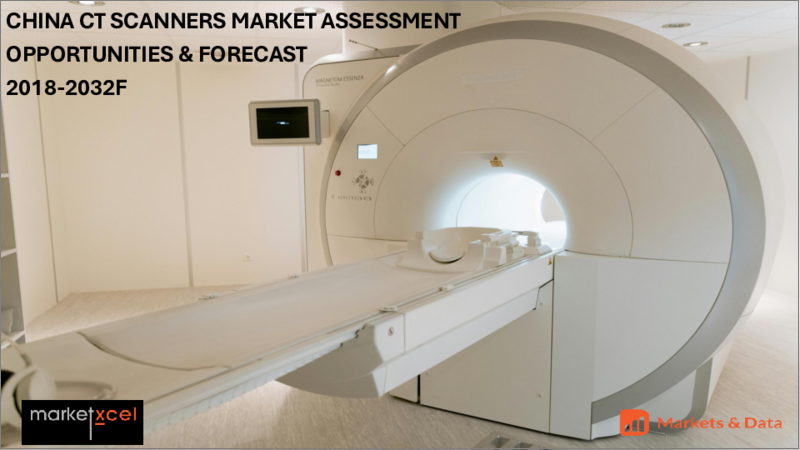|
|
市場調査レポート
商品コード
1564653
CTスキャナーの中国市場の評価:タイプ別、技術別、用途別、エンドユーザー別、地域別、機会、予測(2017年~2031年)China CT Scanners Market Assessment, By Type, By Technology, By Application, By End-user, By Region, Opportunities and Forecast, 2017-2031F |
||||||
カスタマイズ可能
|
|||||||
| CTスキャナーの中国市場の評価:タイプ別、技術別、用途別、エンドユーザー別、地域別、機会、予測(2017年~2031年) |
|
出版日: 2024年10月03日
発行: Markets & Data
ページ情報: 英文 125 Pages
納期: 3~5営業日
|
全表示
- 概要
- 図表
- 目次
中国の医療診断向けCTスキャナーの市場規模は、2023年の15億3,692万米ドルから2031年に28億4,473万米ドルに増加すると予測され、2024年~2031年にCAGRで8.00%の成長が見込まれます。市場の成長促進要因は、高齢化、慢性疾患の増加、イメージング技術の強化、がんの早期発見の重視、国全体の医療サービスの向上です。
医療における需要の増加と技術の進歩が、中国のCTスキャナー市場の成長を後押ししています。慢性疾患の負担の増加は、先進の診断機器への需要を高める大きな要因です。中国の人々が高齢化し、中産階級が拡大する中、高解像度の医用画像に対する需要が高いことから、多くの病院がCTスキャナーに投資しています。保険適用範囲の拡大や医療インフラへの投資により、医療システムはより利用しやすくなっています。CTスキャナーは現在でも、診断の目的でほぼすべての大病院や小病院に設置されているため、市場は依然として成長段階にあります。低線量放射線やAIを活用した画像処理などの新製品が発売され、よりよい患者ケアに向け最新の機器を導入しようとする病院の注目を集めています。
さらに、国内メーカーは国際ブランドに代わる費用対効果の高い製品を提供することで勢いを増しており、市場競合の激化に寄与しています。全体として、中国における医療部門の近代化と、病院によるCTスキャナーの購入が徐々に増加していることが、市場の成長促進要因となっています。
中国のCTスキャナー市場は、AIと機械学習技術の進歩に大きな影響を受けています。AIを利用したイメージングソリューションは、自動画像分析、病変検出、予測分析を可能にすることで、診断の精度とワークフロー効率を高めています。さらに、AIをCTスキャナーに統合することで、画像再構成技術が向上し、スキャン時間が短縮され、画質が向上します。また、先進のソフトウェアアルゴリズムを開発することで、より正確な診断とより優れたリスク評価が可能になります。もう1つの重要な進歩は、データの保存と分析に用いるクラウドベースソリューションの導入で、遠隔診察と共同診断が容易になります。さらに、中国が国内の製造能力を高め、外国技術への依存を減らすことに注力していることが、CTスキャナー市場の技術革新と費用対効果を促進しています。これらの進歩は総体的に、中国におけるより正確で効率的、かつ利用しやすい画像診断ソリューションの実現に寄与しています。
例えば2024年5月、Siemens Healthineers AGはXi'an Daxing Hospitalと8年間の戦略的提携を結び、治療の質と患者ケアを向上させました。Siemens Healthineers AGは、Xi'an Daxing Hospitalの5G Diagnostic and Treatment Centerにおける先進のイメージング技術の統合を含む、病院の各部門の発展とイメージング設備のアップグレードに関与する予定です。この合意は、中国の病院がイメージング技術とインフラを進歩させるというコミットメントを形成し、直接的に中国のCTスキャナー市場に影響を与え、市場成長を促進します。
当レポートでは、中国のCTスキャナー市場について調査分析し、市場規模と予測、市場力学、主要企業の情勢などを提供しています。
目次
第1章 プロジェクトの範囲と定義
第2章 調査手法
第3章 エグゼクティブサマリー
第4章 中国のCTスキャナー市場の見通し(2017年~2031年)
- 市場規模の分析と予測
- 金額
- 数量
- 市場シェアの分析と予測
- タイプ別
- 技術別
- 用途別
- エンドユーザー別
- 地域別
- 市場シェア分析:企業別(金額)(上位5社とその他 - 2023年)
- 市場マップ分析(2023年)
- タイプ別
- 技術別
- 用途別
- エンドユーザー別
- 地域別
第5章 需給分析
第6章 輸入と輸出の分析
第7章 バリューチェーン分析
第8章 ポーターのファイブフォース分析
第9章 PESTLE分析
第10章 価格分析
第11章 市場力学
- 市場促進要因
- 市場の課題
第12章 市場の動向と発展
第13章 規制枠組みとイノベーション
- 規制当局の承認
第14章 特許情勢
第15章 ケーススタディ
第16章 競合情勢
- マーケットリーダー上位5社の競合マトリクス
- 上位5社のSWOT分析
- 主要企業上位10社の情勢
- Siemens Healthineers AG
- Fujifilm Holdings Corporation
- Canon Medical Systems Corporation
- GE HealthCare Technologies Inc.
- Koninklijke Philips N.V.
- NEUSOFT China Co., Ltd.
- Shenzhen Anke High-tech Co., Ltd.
- NeuroLogica Corporation
- Shanghai United Imaging Healthcare Co., LTD
- Shimadzu Corporation
第17章 戦略的推奨
第18章 当社について、免責事項
List of Tables
- Table 1. Pricing Analysis of Products from Key Players
- Table 2. Competition Matrix of Top 5 Market Leaders
- Table 3. Mergers & Acquisitions/ Joint Ventures (If Applicable)
- Table 4. About Us - Regions and Countries Where We Have Executed Client Projects
List of Figures
- Figure 1. China CT Scanners Market, By Value, In USD Million, 2017-2031F
- Figure 2. China CT Scanners Market, By Volume, In Million Units, 2017-2031F
- Figure 3. China CT Scanners Market Share (%), By Type, 2017-2031F
- Figure 4. China CT Scanners Market Share (%), By Technology, 2017-2031F
- Figure 5. China CT Scanners Market Share (%), By Application, 2017-2031F
- Figure 6. China CT Scanners Market Share (%), By End-user, 2017-2031F
- Figure 7. China CT Scanners Market Share (%), By Region, 2017-2031F
- Figure 8. By Type Map-Market Size (USD Million) & Growth Rate (%), 2023
- Figure 9. By Technology Map-Market Size (USD Million) & Growth Rate (%), 2023
- Figure 10. By Application Size Map-Market Size (USD Million) & Growth Rate (%), 2023
- Figure 11. By End-user Map-Market Size (USD Million) & Growth Rate (%), 2023
- Figure 12. By Region Map-Market Size (USD Million) & Growth Rate (%), 2023
China CT scanners market in medical diagnostics is anticipated to experience a CAGR of 8.00% from 2024 to 2031, increasing from USD 1,536.92 million in 2023 to USD 2,844.73 million by 2031.The market growth is driven by aging population, increased chronic diseases, enhanced imaging technologies, emphasis on early detection of cancers, and improved healthcare services across the country.
The increasing demands in healthcare and the advancement of technology are fueling the growth of the CT scanners market in China. The rising burden of chronic illnesses is a major factor that heightens the demand for advanced diagnostic equipment. With the Chinese population growing older and the middle class expanding, many hospitals are investing in CT scanners due to the high demand for high-resolution medical imaging. The healthcare system is becoming more accessible because of increased insurance coverage and investments being made in the medical infrastructure. Since CT scanners are still set up at almost all major and minor hospitals for diagnosing purposes, the market remains in a growth phase. New product launches, such as ones with low-dose radiation and AI-enhanced imaging, have been drawing the attention of hospitals looking to add the newest equipment to their fleets for better patient care.
Moreover, domestic manufacturers are gathering good momentum by offering cost-effective alternatives to international brands, thus contributing to a highly competitive market. Overall, the modernization of the healthcare sector in China and a gradual rise in hospital acquisitions of CT scanners are driving market growth.
China CT scanners market is being significantly influenced by advancements in artificial intelligence (AI) and machine learning technologies. AI-powered imaging solutions are enhancing diagnostic accuracy and workflow efficiency by enabling automated image analysis, lesion detection, and predictive analytics. Additionally, integrating AI with CT scanners improves image reconstruction techniques, reduces scan times, and enhances image quality. Developing advanced software algorithms also enables more precise diagnostics and better risk assessment. Another key advancement is the implementation of cloud-based solutions for data storage and analysis, facilitating remote consultations and collaborative diagnostics. Furthermore, China's focus on increasing domestic manufacturing capabilities and reducing reliance on foreign technology is driving innovation and cost-effectiveness in the CT scanners market. These advancements are collectively contributing to more accurate, efficient, and accessible diagnostic imaging solutions in China.
For instance, in May 2024, Siemens Healthineers AG signed an eight-year strategic collaboration with Xi'an Daxing Hospital to enhance their treatment quality and patient care. Siemens Healthineers AG will be involved in the development of the hospital's departments and the upgrade of imaging facilities, which includes the integration of advanced imaging technology at the 5G Diagnostic and Treatment Center of Xi'an Daxing Hospital. Directly, it will impact the CT scanners market in China since the agreement forms a commitment from Chinese hospitals to advance imaging technologies and infrastructures, hence driving market growth.
Impact of Technological Advancements on China CT Scanners Market
The impact of technological advancements has been acting as a strong positive influence on the CT scanners market in China by way of improvement in diagnostic accuracy and speed. Major facilitators of demand for modern CT systems have been brought about with faster imaging techniques, higher resolution scanners, and the introduction of software for data analysis. Not only does it improve patient outcomes, but it also meets the increasing demand for health services that is being brought about by China's aging population. Utilization of advanced algorithms in CT scanners, like iterative reconstruction helps in delivering lower radiation dose and high-resolution images for the diagnosis of neurodegenerative disorders, which are more prominent in geriatric population.
For instance, in November 2023, Hiroshima University's Department of Diagnostic Radiology signed a collaborative agreement with Canon Medical Systems Corporation and started clinical research studies utilizing Canon Medical's Photon-Counting Computed Tomography (PCCT) system. The two groups started working together on evaluating the clinical value of the data acquired by PCCT, further developing diagnostic information, and perfecting imaging protocols. The Photon-Counting CT is a device that carries a next-generation photon-counting detector to achieve high diagnostic accuracy through X-ray energy analysis based on material differentiation.
Increased Investments in CT Scanners Drive Market Growth
Increased funding for CT scanners in China is one of the leading factors contributing to growth in market demand and driving forces for technological advancement in imaging and making more diagnostic tools available. An investment of this kind leads to accelerated innovation, hence increased demand and improvement in the general health infrastructure, besides commanding a robust CT scanners market that is dynamic. Rising market growth in view of new developments within the medical imaging sector of China is characterized by increasing investments in computed tomography scanners. For instance, Genertec Universal Medical Group (Genertec) took over 85% equity of Case Hendar Medical Technology Wuxi Co., Ltd. (Case Hendar) for USD 65.45 million (RMB 467.5 million), eventually making the latter an indirect subsidiary of the company. Case Hendar's acquisition, whose operations are in Beijing, Shanghai, and Guangzhou, further enforces the management function of medical equipment at Genertec. Besides, Genertec also signed a strategic cooperation agreement with well-known companies such as Philips and Elekta on after-sales service and spare parts.
Moreover, in August 2023, Suzhou-based Kunshan Yiyuan Medical Technology Co., Ltd. closed a Series B financing of USD 14 million (RMB 100 million) led by Everest Venture Capital to further develop its CT X-ray tubes, a key component of a CT scanner. Kunshan Yiyuan Medical has developed CT tubes - 2.0MHU, 3.5MHU, 4.0MHU, 5.3MHU, 6.3MHU, and 8.0MHU, which can match more than 90% of domestic CT equipment. This funding will help Kunshan Yiyuan Medical to expand its production of CT tubes, which can cut China's reliance on imports of CT tubes and further develop local production to support the technological advances of medical imaging in the country.
Similarly, for instance, in September 2023, a Beijing-based medical imaging startup Quantum (Beijing) medical devices co., ltd raised USD 14 million (RMB 100 million) in Series C funding. The funding round was led by China International Capital Corporation, with participation from Haixia Capital Management Co Ltd and Shenzhen Guoqi Real Estate Group Ltd. Funding would be used to develop new products, capacity expansion, and operational enhancement. The company manufactures diagnostic imaging solutions including CT scanners, digital radiography, MRI systems, and C-arm systems.
Technology Segment Leads in China's CT Scanners Market Share
The technology segment is likely to dominate the China CT scanners market, resulting from rapid developments in the technologies of the segment and increasing demand for high-performance imaging. For instance, in September 2023, Canon Medical Systems Corporation launched Aquilion ONE GENESIS 640CT with better resolution and efficiency. Manufactured from Canon Medical's Dalian plant, this model speaks volumes about the localized production advantage: quicker response to market demand and confirmation of global quality standards.
The investment represents one milestone in the Chinese medical technology sector, representing very high international standards to the CT scanners market. Thus, the Dalian-based Canon Medical can better answer local needs. Such programs enable local production, whereby it can serve for fast delivery and customization. Initiatives like these even drive the broader diffusion of modern technologies in a region. This growing focus on early diagnosis and personalized medicine increases the demand for high-end imaging modalities. The technology segment will hold a significant share of the market due to the growing demand from healthcare providers for more accurate and timely diagnostic solutions. This constitutes a part of the wider drive toward incorporating advanced technological capabilities into diagnostic and treatment practices with the dual aim of raising the level of diagnostics and care. All these factors make this segment an important driving segment in the CT scanners market in China.
Future Market Scenario (2024-2031F)
The future market scenario of CT scanners in China will show great growth due to innovative technologies, together with governmental support. The Chinese government encourages medical technology development through its policy 'Healthy China 2030' to develop access and quality across the nation. The plan requires a heavy investment in the field of medical imaging technologies in view of the need created by the increasing aging population and the increase in chronic diseases such as cancers and cardiovascular diseases.
Increased emphasis on the localization of high-value medical devices has begun to change market dynamics. The supportive policies towards local innovations reduce the dependence on imports and encourage emergence at a local level. The next important trend is artificial intelligence embedded in medical devices. The government gave significant impetus to the innovations in remote imaging and diagnostics with AI. This, in turn, is improving the capacity and availability of computed tomography systems, most of which are in regional hospitals. Governmental support, local production initiatives, and technological innovations indicate that the China CT scanners market is projected to boom for years to come.
For instance, in May 2023, Shanghai United Imaging Healthcare Co., Ltd. (United Imaging) introduced a whole portfolio of product lineups at the China International Medical Equipment Fair (CMEF), including AI-enhanced PET/CT, PET/MR, MR, CT to DR systems. The two main products developed for this exhibition are a total-body PET/CT system-the uEXPLORER and the uRT-linac 506c. This latter system combines a linear accelerator with a CT imager for highly proficient radiotherapy. The uHOR Cube Integrated Operating Room was fitted out with the most up-to-date advanced imaging and surgical technologies, thus allowing precision surgery. Besides, United Imaging introduced AI platforms, such as uAIFI and uEXCEL, designed to improve imaging performance and safety. This highlights United Imaging's efforts toward improving Diagnostic Imaging in China. Such efforts can fuel the growth of CT scanners in the market.
Key Players Landscape and Outlook
Tremendous demand for China CT scanners could be foreseen with every new technological innovation, coupled with favorable promulgated policies by the government. Leading companies keep the limelight on new technology development with advancements in AI-enhanced imaging, high-resolution scanners, and faster diagnostic capabilities. The key market players are expanding their market presence through strategic partnerships, mergers, and acquisitions, collaborating with local and international players, and enhancing their distribution networks. Also, Government initiatives, such as the 'Healthy China 2030' plan, propose a front toward local manufacturing, reducing dependency on imports further acting as an incentive to the China CT scanners market.
For instance, in April 2024, for celebration of the 89th CMEF, Siemens Healthineers AG and Shanghai Electric Group Co., Ltd. proudly declared that the ultramarine series would make its debut through strategic cooperation, which includes the Ultramarine 1.5T MRI and Ultramarine 128 and 32 CT scanners. The product launch shows its strategic partnership furthers the "national intelligence innovation" strategy of Siemens Healthineers. Both parties have put a strong focus on intelligent and energy-efficient design, local innovation, and increased cooperation. The partnership was driven by China's "Healthy China 2030" and the "14th Five-Year Plan", which thus lays the foundation for easy access to quality, high-end medical devices contributing to the bigger goal of China in furthering its healthcare industry.
Similarly, in December 2023, GE HealthCare Technologies Inc. introduced its first domestically manufactured ultra-high end CT scanner - Revolution Apex Expert, at the China International Import Expo. This new platform has a high-energy imaging chain that drives the speed of CT to 0.23 seconds, enabling fast heart imaging in 19.5 milliseconds. Production at the Beijing facility of GE HealthCare Technologies Inc. is targeted at fulfilling precise diagnostic needs and positioning for a strategy of local innovation and high-end device promotion.
Table of Contents
1. Project Scope and Definitions
2. Research Methodology
3. Executive Summary
4. China CT Scanners Market Outlook, 2017-2031F
- 4.1. Market Size Analysis & Forecast
- 4.1.1. By Value
- 4.1.2. By Volume
- 4.2. Market Share Analysis & Forecast
- 4.2.1. By Type
- 4.2.1.1. Stationary CT Scanners
- 4.2.1.2. Portable CT Scanners
- 4.2.2. By Technology
- 4.2.2.1. High-slice CT Scanners
- 4.2.2.2. Mid-slice CT Scanners
- 4.2.2.3. Low-slice CT Scanners
- 4.2.2.4. Cone-beam CT Scanners
- 4.2.3. By Application
- 4.2.3.1. Cardiovascular
- 4.2.3.2. Orthopedics
- 4.2.3.3. Neurology
- 4.2.3.4. Oncology
- 4.2.3.5. Others
- 4.2.4. By End-user
- 4.2.4.1. Hospitals
- 4.2.4.2. Diagnostic Imaging Centers
- 4.2.4.3. Other End-users
- 4.2.5. By Region
- 4.2.5.1. South
- 4.2.5.2. East
- 4.2.5.3. North
- 4.2.5.4. Northeast
- 4.2.5.5. Central
- 4.2.5.6. Southwest
- 4.2.5.7. Northwest
- 4.2.6. By Company Market Share Analysis (Top 5 Companies and Others - By Value, 2023)
- 4.2.1. By Type
- 4.3. Market Map Analysis, 2023
- 4.3.1. By Type
- 4.3.2. By Technology
- 4.3.3. By Application
- 4.3.4. By End-user
- 4.3.5. By Region
5. Demand Supply Analysis
6. Import and Export Analysis
7. Value Chain Analysis
8. Porter's Five Forces Analysis
9. PESTLE Analysis
10. Pricing Analysis
11. Market Dynamics
- 11.1. Market Drivers
- 11.2. Market Challenges
12. Market Trends and Developments
13. Regulatory Framework and Innovation
- 13.1. Regulatory Approvals
14. Patent Landscape
15. Case Studies
16. Competitive Landscape
- 16.1. Competition Matrix of Top 5 Market Leaders
- 16.2. SWOT Analysis for Top 5 Players
- 16.3. Key Players Landscape for Top 10 Market Players
- 16.3.1. Siemens Healthineers AG
- 16.3.1.1. Company Details
- 16.3.1.2. Key Management Personnel
- 16.3.1.3. Products and Services
- 16.3.1.4. Financials (As Reported)
- 16.3.1.5. Key Market Focus and Geographical Presence
- 16.3.1.6. Recent Developments/Collaborations/Partnerships/Mergers and Acquisition
- 16.3.2. Fujifilm Holdings Corporation
- 16.3.3. Canon Medical Systems Corporation
- 16.3.4. GE HealthCare Technologies Inc.
- 16.3.5. Koninklijke Philips N.V.
- 16.3.6. NEUSOFT China Co., Ltd.
- 16.3.7. Shenzhen Anke High-tech Co., Ltd.
- 16.3.8. NeuroLogica Corporation
- 16.3.9. Shanghai United Imaging Healthcare Co., LTD
- 16.3.10. Shimadzu Corporation
- 16.3.1. Siemens Healthineers AG
Companies mentioned above DO NOT hold any order as per market share and can be changed as per information available during research work.






